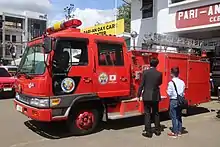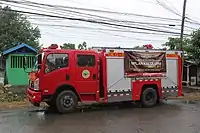Bureau of Fire Protection
The Bureau of Fire Protection (Filipino: Kawanihan ng Pagtatanggol sa Sunog[4]) is the government fire service of the Philippines. It is under the jurisdiction of the Department of the Interior and Local Government.
| Kawanihan ng Pagtatanggol sa Sunog | |
 | |
| "Save Lives and Properties" | |
| Operational area | |
|---|---|
| Country | Philippines |
| Agency overview | |
| Established | January 29, 1991 |
| Employees | 25,000 (2019 estimate) [1] |
| Annual budget | ₱22.95 billion (2020)[2] |
| Fire chief | FDIR. Jose S. Embang Jr. |
| Facilities and equipment | |
| Stations | 51 (cities), 597 (municipalities) (2018)[3] |
| Trucks | 2,683 (2018)[3] |
| Website | |
| http://bfp.gov.ph/ | |
Functions and duties
According to the Bureau's website, their primary functions are:[5]
- Prevention and extinguishing all destructive fires;
- Enforcing the Fire Code of the Philippines (PD 1185) and related laws;
- Investigate the causes of fires and if necessary, file a complaint to the city or provincial prosecutor relating to the case;
- In events of national emergency, will assist the military on the orders of the President of the Philippines;
- And establish at least one fire station with all personnel and equipment per municipality and provincial capital.
History
The Bureau of Fire Protection was formed from the units of the Philippine Integrated National Police's Office of Fire Protection Service on January 29, 1991, through a law named Republic Act 6975 creating the present Interior Department and placing the fire service under its control.[6]
The enactment of Republic Act 6975, otherwise known as the Department of Interior and Local Government Act of 1990 which took effect on January 1, 1991 paved the way for the establishment of the Philippine National Police (PNP), Bureau of Fire Protection (BFP) and Bureau of Jail Management and Penology (BJMP) as separate entities. Specifically, the Fire Bureau’s charter was created under Chapter IV (Section 53 to 59) and carried-out through the provisions of Rule VII (Sections 49 to 58) of the Implementing Rules and Regulations of the said law. The organization was then placed under the direct supervision of the DILG Undersecretary for Peace and Order. The succeeding approval of the Appropriation Act of 1991 has also caused the inaugural operation of the Bureau of Fire Protection on August 2, 1991 as a distinct agency of the government, with its initial preparation of Operation Plans and Budget (OPB) undertaken by the staff of the Office of the National Chief Fire Marshal at Camp Crame, Quezon City headed by then F/Brigadier General Ernesto Madriaga, INP (1990-1992) that took over from the long reign of F/Major Primo D Cordeta (Ret.) the first Chief Fire Marshal (1978-1989). Gen. Madriaga served as the BFP first Acting Fire Chief/Director from 1991 to 1992. BFP is responsible for ensuring public safety through prevention and/or suppression of all destructive fires on buildings, houses, and other similar structure, forests, and land transportation vehicles and equipment, ships/vessels docked at piers, wharves or anchored at major seaports, petroleum industry installations. It is also responsible for the enforcement of the Fire Code of the Philippines (PD 1185) and other related laws, conduct investigations involving fire incidents and causes thereof including the filing of appropriate complaints/cases.[7]
Organization
The bureau has a National Headquarters, a Special Rescue/HAZMAT Unit, an Emergency Medical Services, a Special Operations Unit. an Arson Investigation Unit, the Fire Law Enforcement Service, and the Fire National Training Institute.
Each Region has its own BFP fire region, headed by a person with the rank of Fire Chief Superintendent (Fire Brigadier General) or Fire Senior Superintendent (Fire Colonel).
Leadership
- Commander-in-Chief: Pres. Rodrigo Roa Duterte
- Secretary of the Interior and Local Government: Sec. Eduardo M. Año
- Undersecretary for Public Safety: Usec. Nestor F. Quinsay Jr.
- Chief, Bureau of Fire Protection: Fire Dir. Jose S. Embang Jr.
- Deputy Chief for Administration: FCSUPT. Roel Jeremy G. Diaz
- Deputy Chief for Operations: FCSUPT. Wilberto Rico Neil A. Kwan Tiu
- Chief, BFP Directorial Staff: FCSUPT. Jesus P. Fernandez
Equipment
The bureau provides fire appliances depend on their jurisdiction capabilities. each cities and municipalities in the Philippines have one or more fire appliances to serve.
| Photos | Model | Origin | Type | Note |
|---|---|---|---|---|
 |
Isuzu Forward | Medium Fire engine | New Euro 4 variant was procured under Duterte Administration. | |
 |
Isuzu Giga | Heavy Fire engine | New Euro 4 variant was procured under Duterte Administration. | |
 |
MAN TGM 18.250 Rosenbauer TLF 4000 | Heavy Fire engine | Procured under the Aquino Administration. used in Highly-Urbanized Cities | |
 |
Pierce Dash 100 | Aerial Fire engine | Acquired under Quezon City Government | |
 |
Hino Ranger | Medium Fire engine | ||
 |
1982 Ford Roughneck F800 | Medium Fire engine | Procured during 1980's under the Marcos Administration. used in municipalities. | |
 |
Hyundai HD120 | Medium Fire engine | ||
 |
Dongfeng Hubei 4x2 | Medium Fire engine | Procured under the Aquino Administration. used in municipalities | |
 |
Isuzu NDR | Light Fire engine |
References
- Tupas, Emmanuel. "50% of firefighters don't have complete protective gear – BFP". philstar.com.
- Aika Rey (8 January 2020). "Where will the money go?". Rappler. Retrieved 29 May 2020.
- Mayuga, Jonathan L.; Mayuga, Jonathan L. (March 21, 2018). "Tragedy of fires: Death and destruction in the Philippines | Jonathan L. Mayuga". BusinessMirror.
- "Remarks of Gen Eduardo M Ano (Ret) OIC, DILG - Fire Service Convention Davao" (PDF). Davao City: Department of Interior and Local Government. 8 June 2018. Retrieved 6 July 2020.
- "Mandates and functions". bfp.gov.ph. Retrieved 2020-08-24.
- "R.A. 6975". lawphil.net.
- "History of BFP". Bureau of Fire Protection - Region 1. Retrieved 9 October 2020.
 This article incorporates text from this source, which is in the public domain.
This article incorporates text from this source, which is in the public domain.